LBP Workshop: Points and (P)Layered Level Design
 Monday, December 8, 2008 at 2:32PM
Monday, December 8, 2008 at 2:32PM In LittleBigPlanet, point bubbles are the closest functional equivalent to Super Mario Brother Coins. Coins are brilliantly designed to encourage players to jump instead of forcing them to do so, offer a way for players to control their difficulty by going after harder to reach coins, and reward the player with extra lives after collection 100. In Super Mario Brothers, if the player sees a coin it is not only obtainable (for Big Mario), but all the coins on the screen can be gathered safely in a single pass through a level. Points in LBP share, or can share all of these positive reinforcing functions with proper placement. But points support an additional layer of functionality that I will explore in this workshop.
First I'll run through a few do's and don'ts of basic point placement:
- Don't give away points. Always make the player work for their points so that they function as rewards. Remember, Mario had to jump for every coin even with coin blocks multiple coins. Working for your rewards may seem simple, but it's highly effective. So, don't put LBP points along the basic or main path of progression. And definitely don't litter any part of your level with a swimming pool load of points that players must "swim" through. Doing this only cheapens your level, causes frame rate issues, and bloats the scale of your leader boards.
- Place points in your level for a purpose. Point placement is all about balance. If the purpose of your points is to reward players to getting to hard to reach places, then make sure that the hardest to reach areas gives the most points as a reward, and the rest of the areas are balanced accordingly. If the purpose of your points is to encourage platforming, then be sure that you don't put any points in places that will harm or set back the player significantly.
- Don't ruin the visual impact of your level with points. Think about it this way. Points are a kind of temporary positive space. Before being grabbed, they take up space and prevent solid objects from passing through them. In this way, the arrangement of points can change the relationship between positive and negative space in your level. When arranging points, step back (zoom out) from the game view and check the spatial balance of your level frequently.
Points have two additional functions that can add new, dynamic layers to the potential of any LBP level.
- Points stop race timers: For any given race, carefully placed points can give players a way of stopping thus achieving their best racing times. Depending on the arrangement, players can balance the risk of a more difficult path with the reward of more points and a faster time. This feature has a lot of potential.
- Points can be chained to build point multipliers: Every 5 points gathered in quick succession adds +1 to the point multiplier. Wait too long between grabbing points and the chain will stop, multiply your points, and add the product to your total.
- All players contribute to the same multiplier. This feature allows players to work together for a high score. With more players, the team can cover move ground at once allowing them to chain otherwise unchainable sections of a level. As I have said in my four part review & repair, team chaining achieves the highest level of co-op design: level 6. organic co-op.
Depending on the implementation chaining points can create flow, momentum, and suspension across different gameplay ideas. Players going for the highest scores will look for that next point bubble or group of bubbles anywhere. Yes, chaining point bubbles is an abstract mechanic. But it is a mechanic that enhances the rest of the core, concrete mechanics. Like chaining enemies in the 2D Mario platformers for 1ups or chaining beats in Donkey Kong Jungle Beat, the overall gameplay is better served by the addition.
Going for that high score can also transform a level to create new alternate paths, or even create folded, accordion, and pure organic gameplay. Just check out this high score video of Donkey Kong Jungle Beat to see what I mean. In this game, players can clap to snag bananas near DK. The more bananas DK snatches up at once, the more points players get. Also, by performing flips and acrobatic moves off the environment/enemies, DK can add multipliers to his score potential. The only catch is, when DK touches the ground, the multiple resets back to zero. In this way, players struggle to remain as airborne as possible thus reinforcing the core dynamic of a platformer; fighting against gravity.
Starting at the 4:00 minute mark, notice how the player builds up his multiplier, grabs the flying squirrel, and flies back to the beginning of the level to pick up the bananas he skipped. Because the developers didn't put any artificial restrictions on the level or where the flying squirrel can go, this marvelous, folded, high score run is possible.
So, in LittleBigPlanet, when designing chainable point paths keep this in mind...
- Don't overdo the points. Though you want the player to be able to chain the points, don't put so many so close together that they're simply running through a pond of points. In the same way that you shouldn't give points away for free, you shouldn't give the player too many points for chaining.
- Push, pull, and control. In general you want to space your points apart so that players must move quickly between them to maintain the chain. However, going at max speed all the time isn't necessary. Like in music, it's important to have variation. Try to arrange your points so that they work with the level design to encourage chaining sections at different speeds. Ultimately, going from fast to slow or visa vera takes a lot of control, which increases the difficulty of your level when chaining.
- Don't worry about making a whole level chainable. If you try to make your whole level chainable, chances are you'll ruin the balance by adding too many points or making the chain path too obvious. Remember, the point placement and the level design work together. If the level isn't suited for appropriate point placement, then don't force it. In fact, it may be better to intentionally design stops or gaps in the chainability of your level for the following reason...
- Multiplayer potential. If you design a stage that's completely chainable for single player, then there won't be much potential left for player to devise new multiplayer/co-op paths and strategies. Chain stops and areas where the player can't grab all the points in one pass naturally function as potential layers of multiplayer gameplay. In other words, LBP levels/strategies can be designed to dynamically change with more players to create more layers of gameplay. Hence, (p)layered level design.
For a perfect example of point placement and (p)layered level design all in one, be sure to check out the racing level in the single player LBP levels titled: Fire Pits.
Now, let's look at some examples from Improvisation #1.
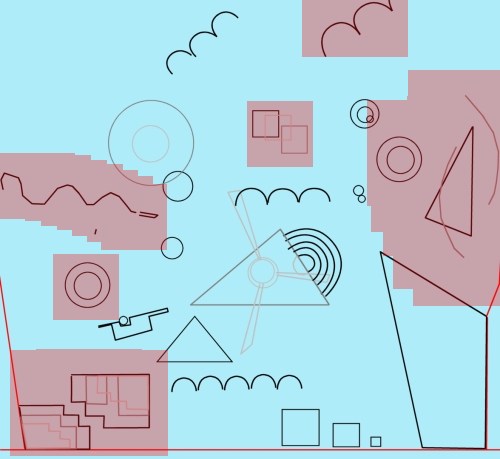
The areas highlighted in red are the examples I'll be focusing on.
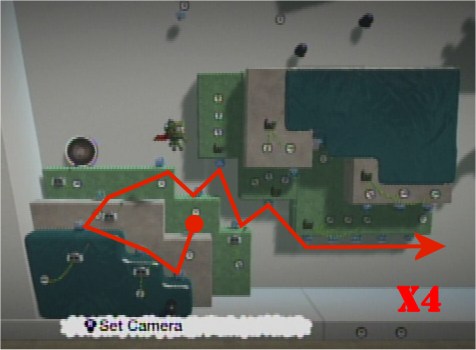
- This is the beginning of the level. Though it looks simple, and the platforming isn't challenging, chaining all of the points presents quite a challenging puzzle. To chain all 15 points, players must understand the shape well and how the 3D layering can help or hinder their progression. The red line represents the path I've found that gets the job done.
- With additional players, this whole area can be skipped and returned to from the top to take advantage of the points inside the "cave" and connected to the tan shapes at the top right.
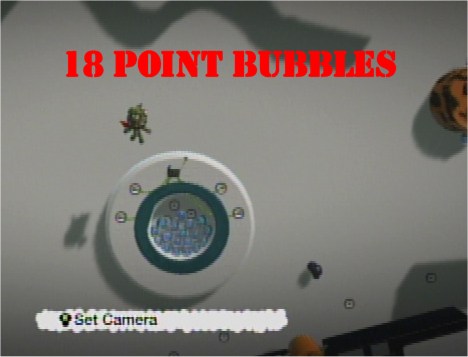
- This is one of the hardest to reach areas in the level. To reward players for making it here, I've tucked away 18 point bubbles inside. I designed this area so that it doesn't chain easily creating a chain stop. The point is to find a way here, and the reward is a determined amount of points. By making the reward significant, preventing this area from easily being chained keeps the over all points balanced.
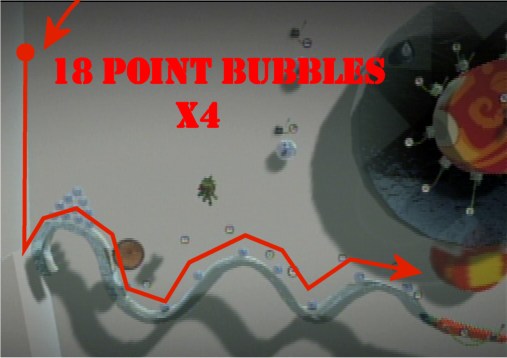
- In this area, players can chain the 8 point bubbles by running along the glass from right to left. However, the incline is too steep on the left most hill for players to climb. In order to chain this entire section, players must find a way to travel up and over this area to the left wall similar to the strategy exhibited in the Donkey Kong Jungle Beat video. By dropping down, players can easily access the 10 points at the top of the hill, and then slide down moving to the right to chain all 18 points.
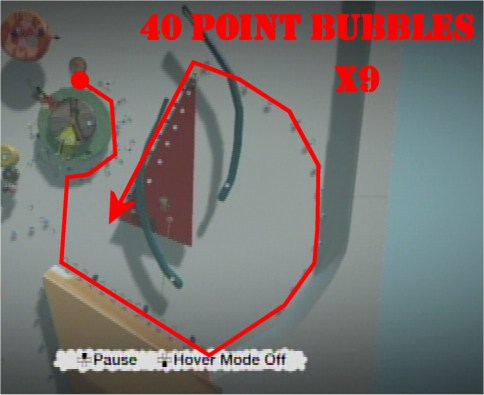
- This section is designed with a complex chain path. By dropping down onto the yellow ramp, players have to be careful to control their speed so that the red triangle is waiting for them when they get to the end. Otherwise, the chain timer will run out. By holding on to the tip at the end of the red triangle ride, players can swing around to the left side of the triangle and slide down to collect all 40 points.
- With two players, it's possible for one person to stall along the left side of the red triangle by repeatedly grabbing while the other travels to some other part of the level to chain additional points. The potential is wide open.
Ultimately, if you don't design every element of your level, including points, to work for the functional good of your level... then what's the point?



Reader Comments (14)
To this day, I can't think of a better implementation of points than in the original Sonic. Rings were plentiful, and mainly served as a means of directing the player and rewarding slick play.
If I could make an analogy real quick...
If Mario Coins are gold, then LBP points are candy (or drugs), and Sonic rings are plastic toys.
I say that to say this...
For the most part, Sonic rings are well placed. As you're zooming through the level, more skillful paths/jumps/maneuvers will score you more rings. My biggest problem with rings comes from how rings are designed as health.
First of all, the level/enemy design in the 2D sonic games is strained enough as it is. Without being able to see/piece together the interconnected branching paths, memorization is the only tool that can make the game work on that level. The faster you run, the more dangerous/probable running into an enemy becomes.
And on that note, Sonic enemies aren't like Mario enemies that are designed with lots of interplay, encouraging the primary mechanics, while dynamically changing the level/objective through contrary motion. Sonic enemies are mainly just shallow annoyances.
So, when you get hit by an enemy or injured on a spike, all of your rings fly out. Like a host of daffodils, they dance about and players try to recover as many as possible. This odd design feature creates a kind of "stop and go" gameplay. It's even possible to hold onto one ring so long, it almost makes Sonic seem invincible. The coins in Mario Kart make you go faster. The rings in Sonic throw a strange colored wrench into the difficulty design.
So, rings come, and rings go. Like plastic toys you try to collect as many as you can, but you find that they're often stolen or lost. And as you progress, you'll find yourself feverishly holding on to the last ring. For when that last one goes, the world becomes a much scarier place. And soon, it'll be game over for everyone.
And that's my sonic coming of age analogy.
Didn't a lot of Sonic enemies switch between vulnerable and dangerous modes? Others came up from the ground, flew in the air, would move around a platform, or fire off projectiles.
Unfortunately, Sonic's speed did make memorization rather than creativity the primary way of dealing with them.
As for rings and powerups, I felt that some were well placed and some I just had to stumble into. I might be able to see a reward, but finding it would require trial and error search through another part of the level. Again this requires more memorization to get better at the game, rather than using platforming and Sonic's speed.
Just a quick word to say thank you for your blog, it provides some interesting & unique gamedesign elements specifically suited for one of the best games around. Keep up the good work (and btw impro #1 is a blast to play !)
@ Bryan Rosander
True that.
@ Khronos
Thanks. Good to hear that you appreciate my articles and my level. As I've said before, it's comments like yours that keep me going.
@post
Great post. I agree that score bubble placement is important, but I think arbitrarily placing score bubbles can also work due to the way the LBP multipler works. If the player wants to maximize his/her score, he/she would figure out an optimum path. The level creator does not necessarily have to make that path unless he/she wants to turn it into gameplay. The average player does not have the patience to replay levels over and over anyway.
Also, score bubbles can help to direct players towards a certain path, especially in multiplayer where everybody is vying to maximize their personal score. They also work like decoration-- they make a level feel less empty. And they are necessary for giving the average player a sense of accomplishment.
@sonic discussion
Old-school sonic had more diverse platforming elements and enemies, and many parts of the level were not solely based on memorization. Some combined pinball mechanics with platforming, and others such as Sonic CD levels focused more on exploration. Enemies were varied and had particular behaviors and characteristics, although I would agree that they were generally more shallow than their Mario counterparts. Personally, replaying Sonic is much more fun than replaying Mario since mastering a Sonic level allows you to attain speed and look cool doing it. Mario just doesn't have that type of visual flair.
@snowflakecat
About LBP points.... true. True.
Oh... did someone ask for visual flair in Mario Bros? Well, here it is.
http://www.youtube.com/watch?v=nG31cLGLP34
http://www.youtube.com/watch?v=DTzs9bcNgMQ
http://www.youtube.com/watch?v=vwIEqNWykzM
http://www.youtube.com/watch?v=D4LUcVIpQGU
Speed. Check. Looking cool. Check. Mastering Mario is about thinking on your toes and playing around with dynamically changing situations. Mastering Sonic is all about memorizing the paths through a static "roller coaster ride."
http://www.youtube.com/watch?v=qkJ49aFaKrA
See what I mean?
I rather blindly ran through most of the first few Sonic games. In my mind, they're that generation's version of Mirror's Edge, and the rings were the red elements of Edge.
The mechanic of the rings was a problem. It seemed like they couldn't make up their mind as to how they wanted to improve on Mario's coins as a mechanic, and I'm not sure it ended up working well with the aesthetic or the plot. Sort of an awkward genre convention at the end of the day, but the level designers used it well.
@ sonic-haters
I love old-school Sonic and still have my Genesis. Also, using new super mario bros to compare with original Sonic is a cheap shot.
@ snowflakecat
I purchased Sonic Mega collection for the Gamecube and played through Sonic Rush 1 & 2 to do research on the 2D Sonic games.
I like the DS Sonic Rush games the best out of all the games.
I'm not a hater. I even played Sonic and the Secret Rings before I just couldn't take it anymore.
@KirbyKid Maybe I'm just old, but the further from the original Sonic game that a title is, the less I consider it a valid part of the franchise. Have you played the original two titles?
I bought 1 on Virtual Console and beat it.
I played through most of 2 recently on the mega collection.
I beat 3 and Knuckles too many times to count as a kid.
I beat Sonic 3D Blast and Sonic Adventure. And I played that crazy racer, Spinball, and even the first GBA sonic title.
I'm curious to understand what you mean by valid part of the franchise. Do you mean quality games design wise? Or do you mean, some games were just pumped out with Sonic's face on them?
What's your favorite Sonic game and why?
I think I'm mostly talking about quality design. Since the Genesis games, I don't think I've been able to stick with a Sonic game's mechanics long enough to know about plot, etc.
If I had to pick a favorite, it would be Sonic 2, in which the head-to-head race mechanic really opened my eyes to the joy of the speed run.
Every time I come back to this post, I want to buy Mirror's Edge more. Maybe the sequel will feature a runner with two tails?
Sonic Rush and Sonic Rush Adventure have a 1v1 race mode. And SRA supports online play.
Hmmm.